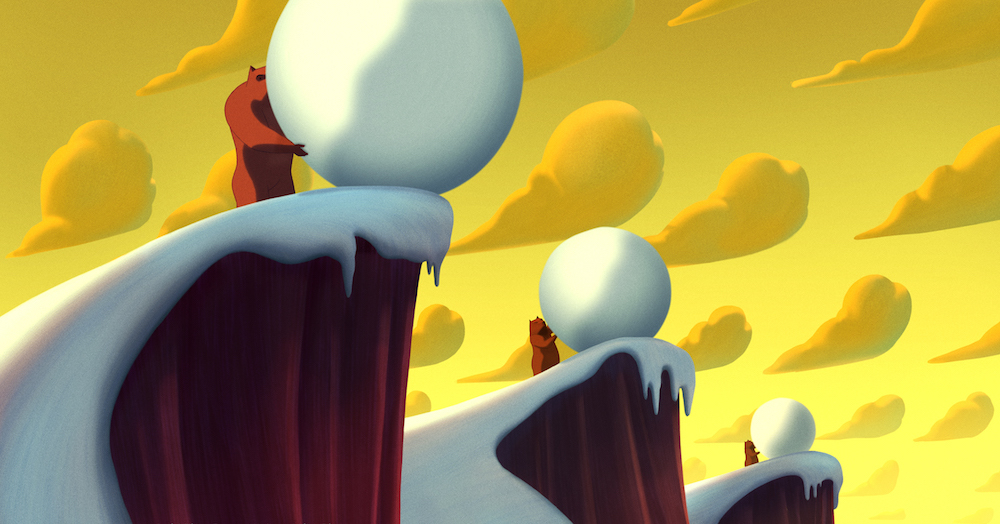Film Review: ‘The Bears’ Famous Invasion of Sicily’

Director: Lorenzo MattottiWith: Toni Servillo, Antonio Albanese, Linda Caridi
Running time: 81 MIN.
A classic Italian children’s book from 1945 gets an update in master illustrator Lorenzo Mattotti’s feature debut, “The Bears’ Famous Invasion of Sicily.” Beautifully drawn with bold colors and appealing shapes, the film’s style is classic animation at its best, clear and pleasing, calculated to charm children and adults alike. The revised storyline, however, about how bears and humans clash, make amends, and then realize they’re too different to live together, can lead to unfortunate and inadvertent interpretations neither Mattotti nor the original author Dino Buzzati intended. In addition, the narrative’s pace, whizzing by from one scene to the next, frustrates an adult’s desire to relish the often-striking images, making the film most suitable for kids incapable of critically engaging with metaphor.
“The Bears’ Famous Invasion” first appeared in print toward the end of World War 2, written and illustrated by the multi-talented Buzzati, whose novel “The Tartar Steppe” was adapted by Valerio Zurlini for his 1976 masterpiece “The Desert of the Tartars.” As usual with children’s stories created by intellectuals (think Jean de Brunhoff’s “Babar” and Antoine de Saint-Exupéry’s “The Little Prince”), the book was ripe for interpretation: Was it saying that mankind had become so venal and corrupted that there’s no redemption? Was it a specifically political metaphor, creating an opposition between communists (the bears) and capitalists (the humans)? Given the way the world has changed in three-quarters of a century, what’s the message now, and is there a danger of it being misinterpreted?
Mattotti and his fellow screenwriters made numerous changes to the storyline, largely to streamline the plot and make it more suitable to a feature-length narrative film. They’ve added a framing structure in the form of an itinerant showman, Gedeone (Antonio Albanese), and his young assistant Almerina (Linda Caridi), who seek shelter from the winter cold in a cave, and accidentally awaken an old hibernating bear (Andrea Camilleri). To ensure he remains friendly, Gedeone and Almerina entertain him with a story from long ago, before bears (apart from this one) disappeared completely from Sicily.
Back then, bears lived in the woods guided by their king Leonzio (Toni Servillo). When his son Tonio (Alberto Boubakar Malanchino) gets swept down the river and captured by humans, Leonzio’s grief is overwhelming and he neglects his duties as leader. Winter sneaks up on the bears before they’ve had a chance to store up food, so it’s proposed they go to the town where they can eat and look for Tonio. The nasty Grand Duke (Corrado Invernizzi) assumes it’s an invasion and sets his troops against the bears, who are temporarily helped by the ruler’s sycophantic wizard De Ambrosiis (Maurizio Lombardi) after the Grand Duke abuses him once too often.
The battle scenes are enchanting, as in the moment when packs of wild boars suddenly turn into balloons and float away, or later when the bears send enormous snowballs down a series of cliffs, each scene beautifully imagined in primary colors. Ultimately, Tonio is found in a circus, the Grand Duke is overthrown, and bears and humans live harmoniously with Leonzio as the King of Sicily. Concord is short-lived however, as some of the bears become corrupted by the worst of human traits and the animals return to the forest: After all, bears are bears and men are men, and mixing only leads to strife.
Though this is Mattotti’s first feature film, he’s justly celebrated for his inventive illustrations, which include scores of memorable covers for The New Yorker magazine, as well as posters, comics, illustrated books, and a short film featured in the animated omnibus “Fear(s) of the Dark.” The pictorial concept of “Bears” is unmistakably his own, with diverse influences ranging from Renaissance painting to Expressionism and De Chirico (the latter also an important influence on Buzzati’s work). Unfussy shapes in warm colors have a delightful rhythmic flow while holding their own equally well as frame grabs. Eliminating a few scenes and elongating others would have allowed for a deeper appreciation of the imaginative visual treats.
By: Jay Weissberg

熱門頭條新聞
- 2025 Edition: Hungary, music video and an anniversary!
- SONY and Kadokawa Group have strengthened their collaboration to maximize their intellectual property
- QUByte Unveils Dark and Nostalgic Adventures for Consoles and PC
- OIAF2025
- Once Human Launching Three New Scenarios & Mobile Version In 2025
- ‘Memoir of A Snail’ to Open Anima Festival 2025
- New STALCRAFT: X Game Mode Revealed in New Trailer Showcased at The Game Awards
- Can CD Projekt Recapture the Magic?
